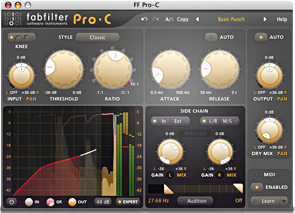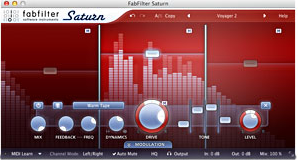~ ~ ~
Continued from the previous post ~ ~ ~
SIGNAL PROCESSOR TECHNOLOGYIt is important to understand that IK Multimedia focuses on creating highly accurate emulations of signal processors using detailed measurements of actual physical hardware devices, and the measurements include circuit component characteristics and behaviors, which is quite different from designing signal processors from scratch . . .
For example, the IK Multimedia Vintage Program Equalizer EQP-1A signal processor plug-in is a digital emulation of the industry classic Pultec Program Equalizer Model EQP-1A . . .

As is the case with most of the vintage signal processors, they originally were designed for use in broadcasting either radio or television audio, as well as in sound reinforcement for concerts, motion picture theaters,and so forth, where the general design goals were three-fold:
(1) Satisfy the various broadcasting requirements mandated by federal broadcasting regulators (for example, this is done by the Federal Communications Commission [FCC] in the US) . . .
(2) Protect various related broadcasting and sound reinforcement equipment by keeping signals within acceptable ranges . . .
(3) Achieve (1) and (2) in a melodic and graceful way by making thoughtful modifications to recorded and live performance audio . . .
As an example, one of the primary uses for limiters in sound reinforcement is to constrain audio signals so that any spikes or exceptionally strong signals are prevented from passing through the signal processing chain to power amplifiers, which if not constrained would overload the power amplifiers and loudspeakers and likely cause damage or catastrophic equipment failures . . .
However, since broadcast engineers and sound reinforcement engineers also work in recording studios, it was inevitable that they would do experiments with the various signal processors to determine whether the signal processors did something useful for recording, mixing, and mastering, which often was the case, so these types of signal processors started as devices for use in broadcasting and sound reinforcement but found uses in recording studios once producers and audio engineers discovered that the signal processors could be used to enhance music and singing, and it is important to understand that the ways these signal processors are used in a recording studio are different from the ways they are used in broadcasting and sound reinforcement, where in particular the focus is on melodic characteristics and behaviors, some of which are a bit subtle with respect to finding and then adjusting "sweet spots" in the various parameter combinations . . .
With the caveat that I understand the importance of dynamics in performances by trained vocalists and musicians playing real instruments, everything changes when such performances are recorded, because while they are sung and played by real people using their singing voices and real instruments, respectively, once the material is captured by a microphone or an electromagnetic device like a guitar pickup, it becomes electromagnetic and when it is digitized, it becomes a set of binary data bits, hence while it probably is a rare treat to hear a chamber orchestra or string ensemble in a carefully designed and acoustically treated listening room, once it becomes electromagnetic and then digital a lot of what makes sense in the real world tends to make little if any practical sense in the universe of digital music production, because the rules are
very different . . .
Explained another way, most if not all of the aforementioned signal processors came into being as a way for broadcasters to introduce a bit of control after the fact to constrain composers, conductors, and performers who tended to be a bit obsessed with extraordinarily wide ranges of dynamics, which might be fine for certain types of live performances but for broadcasting is a major problem that has the vast potential to damage broadcasting equipment and by doing so to jeopardize the ability of broadcasters to meet the various licensing requirements mandated by governmental broadcasting laws and regulations . . .
And since broadcasters are not insensitive fools, they favor signal processors that allow them to meet the various broadcasting standards and requirements but in ways that are melodic and as minimally invasive as possible, where as an example instead of arbitrarily destroying dynamics, the preferred solution is to constrain dynamics to a specific range where there are no extremes, and in this respect it is useful to understand that an electric guitar is the perfect electromagnetic device with respect to being ideal for recording in every respect, while the human singing voice has a dynamic range which is so wide that for recording it is difficult challenge, at best . . .
In other words, an electric guitar basically is either ON or OFF in terms of dynamic range and frequency range, while the human singing voice can range from a nearly inaudible whisper to an ear piercing scream in an instant, which for example can destroy the delicate parts of a $10,000 (US) condenser microphone with one quaver . . .
CALIBRATED STUDIO MONITOR SYSTEM AND THE STUDIOAnd it also is important to understand that until you have a calibrated full-range studio monitor system, there is no way to determine accurately whether there are any problems with virtual instruments and their corresponding sampled sound libraries . . .
In some but not all instances, studio quality headphones can provide clues, but you need a calibrated studio monitor system to determine what is happening accurately with a high degree of confidence . . .
Explained another way, your mixing and mastering studio needs to be a finely tuned instrument, which includes the acoustic characteristics and behaviors of the room itself; the various digital music production equipment (computer, hardware, software, and so forth); and the calibrated studio monitor system, all of which is a Gestalt where everything needs to be good, and until everything is good you are spinning wheels . . .
I designed and built the Surfwhammy sound isolation studio, and it is a room within a room within room, where the innermost room sits on a fully floated floor of compressed rubber made from ground car and truck tires, where part of the logic is that a single nail or woodscrew is sufficient to transfer audio energy from outside inside, as is the case with a hole in the wall which is 1/4" in diameter, so the general idea is to isolate the innermost room from the outside world, and the floor, walls, and ceilings are insulated in specially design ways, which includes using Helmholtz resonating panels, Helmholtz resonators, various absorbers and diffusers, and so forth and so on, where the most recent improvement involved doing some measurements; determining that there was a low-frequency standing wave at approximately 70-Hz; and then correcting the problem by putting six rolls of fiberglass insulation in different sizes and five "cubes" of compressed cellulose insulation in various locations, including the corners, floor, and between the loudspeaker and subwoofer cabinets . . .
In other words, all your equipment--including the calibrated studio monitor system--can be stellar, but if the acoustic characteristics and behaviors of the room are bad, then what you hear will not be accurate . . .
SUMMARYEveryone has goals, and if your goal is to create songs that have the potential to compete with the songs created by major music labels, then one of the realities is that you are competing with companies which routinely have recordings mixed and mastered by audio specialists who have multimillion dollar mixing and mastering studios that are designed and calibrated by trained architects and acoustic engineers using the best equipment available on this planet, which from one perspective makes it an unachievable goal for most people, but the other and much preferred perspective is based on the simple fact that all their elaborate and wildly funded efforts eventually are broadcast by a radio station or sold as digital songs at the iTunes Store, where you can play them on your car audio system, computer, iPad, iPhone, iPod, or whatever playing device suits your fancy, which tends strongly to suggest (a) that if you can play it on a computerized device and it sounds great, then (b) you should be able to record, mix, and master your songs using a digital music production system in such a way that they also sound great . . .
Surfwhammy wrote:For me, this is not a problem, because I "pump" everything with a variety of compressors, limiters, or leveling amplifiers . . .
There are different ways to read what I write at any given time, and while for some songs I "pump" all the instruments and singing, there are levels to "pumping", and it can range from a tiny bit to a
lot, and it also depends on the specific instrument or vocal track, where for example I love snare drum rimshots that "pop", and it requires intense "pumping" as well as a particular type of plate reverberation to make a snare drum rimshot "pop", but other instruments might need to be constrained, so it depends on what works best for the particular instrument or vocal track, as well as how everything fits into the overall mix, and you determine this by listening . . .
In this respect, the primary rule is that "less is nearly always better" when it comes to having a bit of FUN with signal processing and special effects, which makes it like building a miniature ship inside a glass bottle, which is fabulous . . .
Fabulous! 







